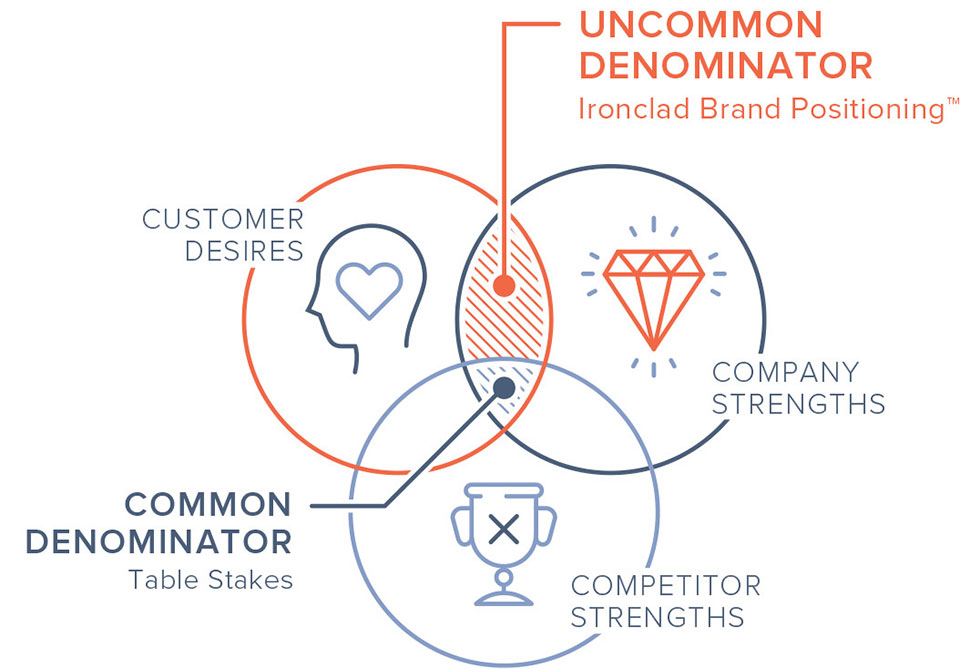To build and sustain long term growth, it’s vital that companies develop a unique brand strategy that’s grounded in target customer’s current and future needs. Ultimately your brand strategy should be what Lindsay Pedersen, brand consultant, and leadership coach, calls your “North Star.” It guides every facet of your business; from the products and services you bring to market to the experiences you deliver to customers.
And yet, too often we see companies that define “brand” in a far more tactical way – pointing to their visual brand identity, latest ad campaign or marketing communications. Another common mistake firms make is failing to take an outside-in, or customer-led, approach to how they conceive, build and introduce new products.
Technology companies are one of the biggest offenders when it comes to this “inside-out” mindset. In essence, they fall in love with their own innovations and product roadmap, developing their strategy predominantly based on what the company’s engineers or founders think, rather than what their target customers actually need.

There are a number of key steps that companies need to take to develop a successful brand strategy. To explore this topic in more detail, I chatted with Pedersen, who recently published her book, “Forging an Ironclad Brand: A Leader’s Guide.” Based on our conversation, here are several key strategies that leaders can implement to define a successful brand strategy to fuel their company’s growth and unleash their competitive advantage in the market:
Reinforce the importance of brand strategy
Every business, from fast-growth startups to well-established companies, needs to step back and think about brand strategy, how their brand is positioned in the market and how they can bolster their approach to win the hearts and minds of their target customers.
The power and impact of a well-conceived brand strategy isn’t always well understood. For example, some companies tend to be more engineering or sales-led, with “brand” compartmentalized as something marketing or PR leads, rather than an overarching strategy that guides every decision the company makes.
“To capture its power as a force multiplier, the entire organization needs to embrace a brand strategy as its guide – its North Star,” notes Pedersen. “Everyone should be marching to the same powerful drumbeat. Managing the brand should be the same as managing the business. If you’re using brand as a discrete activity, confining it to marketing, or thinking of it as an expense rather than an asset, you are missing out on its power.”
Orient around your target customers
We’ve all heard the adage, “you cannot be all things to all people.” Failing to follow this simple marketing rule is one of the biggest mistakes that companies make. “Companies often take a product-focused mindset, reinforcing the fallacy that if we offer an amazing product, then surely it will appeal to anyone and everyone.” Pedersen explains.
But successful brand strategy starts with understanding your target customer needs, and then tooling your product pipeline and innovation around that awareness. “You have to know what you are developing, and who you are optimizing it for. Different people will have different relationships with your product, and different relationships with the problem that your product solves,” Pedersen shares.
Understanding your target customers’ needs, and how your business is uniquely positioned to fill them is the first foundational step to building a successful brand strategy that integrates your business opportunity with the unique niche you fill.
Here are some key questions leaders need to ask to identify their target customers:
- Who are the people who will get the most value from our products and services?
- What segments and customers are most attractive for your brand to target and build products and services for?
- How do you understand the customer journeys for your most valuable customers?
By asking the right questions and orienting around one set of target customers, companies create focus and clarity around what areas they need to invest in. “Simply put, choosing a target customer, and over-serving that set of customers is not only strategic, it’s also practical,” notes Pedersen.
Be what your target customers need
Through marketing research, companies can identify who their potential new and existing most valuable customers are, what they care about, what motivates them and what types of differentiated products, services or offers they’re most likely to want in the future.
Pedersen reinforces this point in her book, as well as the importance of adopting a service mentality across the organization to put yourself in the customer’s shoes and understand their biggest pain points. A service mentality starts with asking how can we learn from our customers, and be there for them without trying to change them. Because, really, who wants that?
Key questions to ask:
- What do customers value most?
- What do they like?
- What problems do they have?
- What does it feel like to have that problem?
She advises that this step requires humility, curiosity, a “beginner’s mindset.”
The better you understand your target customers and what they need, the better positioned you are to serve them. Engaging in this reconnaissance with the right mindset positions you to establish what Pedersen considers “the richest building blocks for your brand strategy.”
Leverage your uncommon denominator

After you get a sound understanding of who your target customers are and what they need, examine how your company is positioned to meet those needs against what your competition is already doing. Here you define and leverage your standout qualities-which Pedersen refers to as your “uncommon denominator.”
She uses a Venn Diagram to help visualize the uncommon denominator framework: the first circle is the customer, the second is the competition and the third is that stand out quality that your company is poised to bring to the table.
Pedersen explains: “The magic of this step is that it exposes a couple of important things: one, at the center of the Venn Diagram, is the things that your customer wants, the things that you’re competitor is good at, and the things that you’re good at. So those are category benefits. Those are table stakes. Those are the things that you have to do because, if you’re going to be in the competitive frame of reference, for your target customer, you just have to have these as cost of entry.”
Deliver on the promise
Your brand, your understanding of your customers, and your commitment to delivering for them is your brand mission – your promise. It represents your unique value to your target customers and your ability to deliver on that. “Your promise of a specific benefit must be backed up by fact. This is referred to as the ‘reason to believe’ and it gives your customer the proof behind your promise,” Pedersen shares.
You earn rewards when you deliver well on your promise-when your target customers know that they can count on you. When you come through for them, you come through for your brand, and you reaffirm its value. Pedersen explains: “Your customer’s emotional reward is a beacon that reminds you, as a leader, of what the organization is all about.”
Your “Ironclad Brand”
Building your ironclad brand means approaching your brand as a holistic construct that radiates through every facet of your company, driving the work you undertake and keeping you on task. It informs how you serve your target customers, how you operate every day as you evolve. Your brand guides you and brings you back to focus.
Pedersen reflects: “It’s not what your customers can do for you, but what you can do for your customers. Think big. Beyond product and service, what is your mission? How can you serve your stakeholders? Differentiate not only for profit today, but for longevity, depth, and substance tomorrow.”



